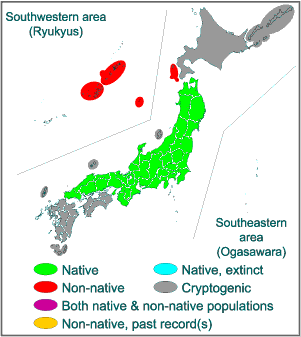
 Japanese |
English
Japanese |
English- Invasive Species of Japan >
- Mammals >
- Rattus rattus
| Invasion information | ||
| Range in Japan | Although natural geographic range is unknown, this species is established on many peripheral islands. |

|
| Origin | Unknown. | |
| Date | Introduction to Ogasawara is estimated to be in 1920s. | |
| Route | Accidental: Hitchhiking on some transport. | |
| Impact | Actually: Predation on plants, sea birds, sea turtles, and land snails. Competiton with herbivorous animals. Damage on agriculture. Carrying parasites including zoonosis. Damage on endangered plants and interference of forest regeneration by predation on seeds. Native organism(s) affected: Birds such as Oceanodroma tristrami, Apalopteron familiare, Synthliboramphus wumizusume in Kyashima Is., Fukuoka Pref., Bulweria bulwerii and Puffinus pacifious in Ogasawara (Bonin) Islands. Plants such as Lobelia boninensis in Ogasawara (predation). Birds such as Columba janthina, Carduelis sinica in Ogasawara (competition). | |
| Regulation in Japan | No action for prevention, mitigation, control, or eradication. | |
| Introduced range in other countries | Worldwide | |
| Reference | Notes |
|
100 of the World’s Worst Invasive Alien Species East, Southeast, and South Asian populations including the Japanese ones are sometimes regarded as a distinct species R. tanezumi, based on differentiation in karyotype and morphology. |